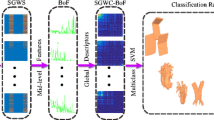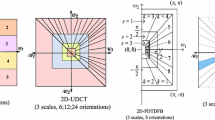Abstract.
A new approach to automatic classification of retinal ganglion cells using multiscale techniques including the continuous wavelet transform, curvature, and standard pattern recognition techniques is described. Each neural cell is represented by its outer contour, and the wavelet transform is calculated from the complex signal defined by the aforementioned contour, leading to the so-called W-representation (Antoine et al. 1996). The normalized multiscale wavelet energy (NMWE) is used to define a set of shape measures associated with the number of details of the shape for a broad range of spatial scales. Next, the more discriminating NMWE coefficients are chosen through a feature ordering technique and fed to statistical classifiers. In addition, the normalized multiscale bending energy (NMBE) is discussed as a means of neural shape description for classification purposes based on the multiscale curvature, i.e. the curvegram, of the neural contour. It is shown that both shape descriptors are suitable for shape classification, presenting similar classification performance. In fact, NMBE has a slightly better recognition rate than NMWE in our experiments. On the other hand, NMWE is less computationally expensive than NMBE, presenting also the potentially useful property of allowing the use of more suitable different analyzing wavelets, depending on the problem under consideration. Therefore, both measures are related and provide a good framework for the design of neural cell description and classification. The methods described in this work have been successfully applied to the classification of two classes of cat retinal ganglion cells, namely α and β (henceforth referred as α-cells and β-cells, respectively), and three statistical classifiers were considered: minimum-distance, k-nearest neighbours and maximum likelihood. The mean recognition rates are near 90%, which is superior to the other shape measures considered. It is argued here that the proposed technique can be adopted as a new general methodology for multiscale shape analysis and recognition, being applicable also to other problems in biological shape characterization in neuroscience and general biomedical image analysis. In the context of analysis of shape complexity, the multiscale energies are coherent with subjective judgements by humans.
Similar content being viewed by others
Author information
Authors and Affiliations
Additional information
Received: 5 November 1997 / Accepted in revised form: 12 June 1998
Rights and permissions
About this article
Cite this article
Marcondes Cesar Jr., R., da Fontoura Costa, L. Neural cell classification by Wavelets and multiscale curvature. Biol Cybern 79, 347–360 (1998). https://doi.org/10.1007/s004220050484
Issue Date:
DOI: https://doi.org/10.1007/s004220050484




